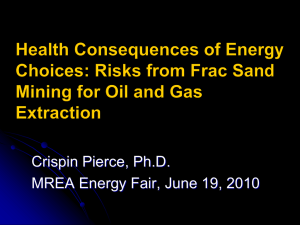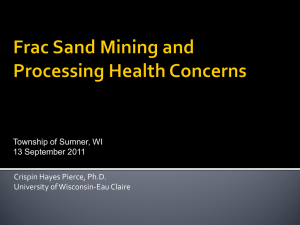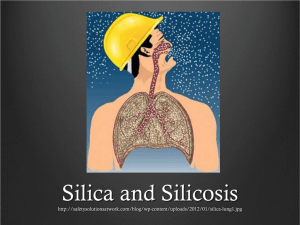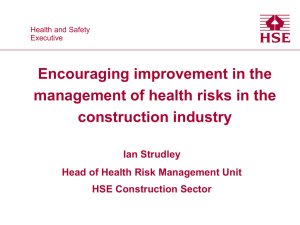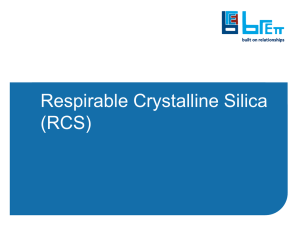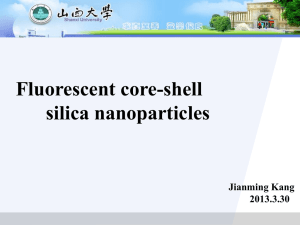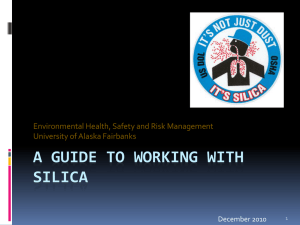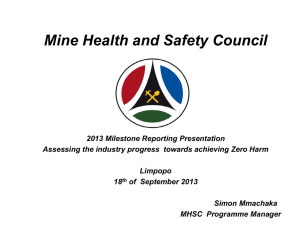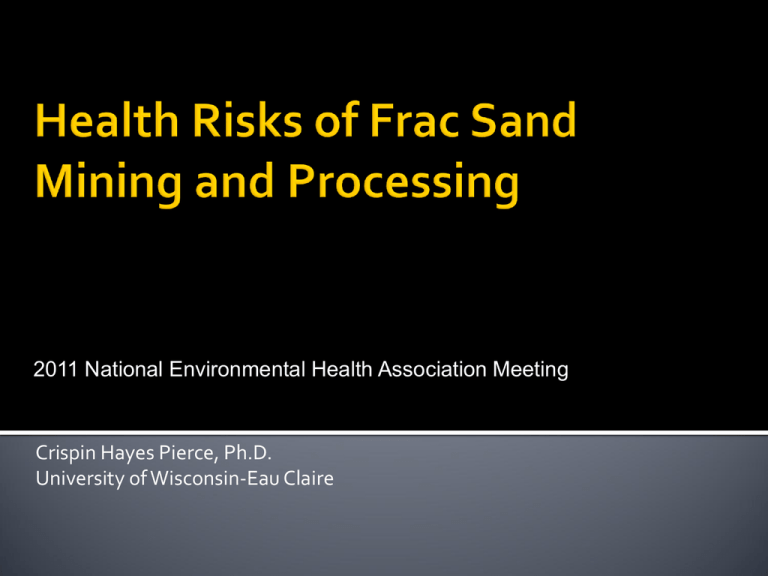
2011 National Environmental Health Association Meeting
Crispin Hayes Pierce, Ph.D.
University of Wisconsin-Eau Claire
Overview of Risks
Complexity of Health Risk Assessment
Sand Mining and Processing
Particulate Matter
Crystalline Silica
Health effects
WDNR Non-Regulation of Silica
Recommendations
Airborne pollutants that can be inhaled.
Waterborne pollutants that can be ingested.
Noise pollution that can be heard.
Light pollution that can be seen.
Wetland loss that affects local water quality.
Truck traffic that affects road safety.
Greenhouse gas generation that increases
climate change.
Many factors contribute to the potential
health risks from an industrial operation:
The type and rates of chemicals being emitted to
the air, water, and soil.
The degree of contact between these chemicals
and the public.
The way that these chemicals cause short-term
and long-term damage to people.
Sand and Gravel Quarry Activities
Sand Conveying
Sand Processing Plant
Hydraulic Fracturing Operation
Increased respiratory symptoms, such as
irritation of the airways, coughing, or difficulty
breathing, for example;
Decreased lung function;
Aggravated asthma;
Development of chronic bronchitis;
Irregular heartbeat;
Nonfatal heart attacks; and
Premature death in people with heart or lung
disease.
The mining and processing activities would
generate PM through blasting, mining,
transporting, and processing the “frac sand”;
and transporting “waste sand.”
Health Effects
Silicosis –a fibrosis (scarring) of the lungs.
Silicosis is progressive and leads to disability
and death.
About 200 people in the US will die this year
due to workplace exposure to silica (NIOSH
2008).
Silicosis: Crude mortality rates by state, U.S. residents age 15 and
over, 1991-1992.
SOURCE: National Center for Health Statistics multiple cause of death data.
Population estimates from U.S. Bureau of the Census.
http://www.cdc.gov/niosh/docs/96-134/pdfs/96-134e.pdf
Lung Cancer – Crystalline silica (quartz) is
classified as a human carcinogen by the
following regulatory agencies:
International Agency for Research on Cancer (IARC)
National Toxicology Program
California Proposition 65
American Conference of Governmental Industrial
Hygienists
Occupational Safety and Health Administration Potential Cancer Hazard
National Institute for Occupational Safety and
Health (NIOSH) – Potential Cancer Hazard
Tuberculosis – Silicosis increases the risk of
tuberculosis.
Autoimmune and Chronic Kidney Disease – Some
studies show excess numbers of cases of scleroderma,
connective tissue disorders, lupus, rheumatoid
arthritis, chronic kidney diseases and end-stage
kidney disease.
Non-Malignant Respiratory Diseases (other than
Silicosis) – Some studies show an increased incidence
in chronic bronchitis and emphysema in workers.
Crystalline silica is a common component of
sand. Sand deposits in Wisconsin have high
levels of crystalline silica.
Silica is a natural component of soils.
However, the “weathered” silica from
agricultural soils is less damaging than the
“freshly-fractured” silica from mining and
processing operations.
The Wisconsin Department of Natural
Resources admits that crystalline silica is a
human carcinogen (Andrew Stewart, 9/2009),
but is not regulating it as a hazardous air
pollutant (NR 445).
While ambient silica concentration data from
Wisconsin are lacking, numerous
occupational and environmental studies have
documented ambient levels (WHO 2000, US
EPA 1996 [in Myers 2010]; and Shiraki and
Holmén 2002, De Berardis et al., 2007, and
Trzepla-Nabaglo et al. 2006).
Five states are now regulating crystalline
silica exposure: the State of California OEHHS
has done a careful job of establishing a noncancer risk threshold of 3 ug/m3, and the
State of Texas has done the same in
establishing a cancer threshold (incremental
risk of 1/100,000) of 0.27 ug/m3. (Myers 2010)
Numerous sources of silica exist in Wisconsin
and many more are proposed for
fractionation (“frac”) sand mining,
processing, and coating.
Public safety would best be served by
establishing an exposure standard to which
all generators must abide. The State of Texas
standard of 0.27 ug/m3 to protect against
unacceptable cancer risk is well-documented
and between other current regulatory limits
(i.e., State of New York value of 0.06 ug/m3
and the State of California value of 3 ug/m3).
De Berardis et al. (2007) Airborne silica levels in an urban area. Sci Total Environ.
2007 Sep 1;382(2-3):251-8. Epub 2007 Jun 5.
EPA (1996) Ambient Levels andNoncancer Health Effects of Inhaled Crystalline
and Amorphous Silica: Health Issue Assessment. EPA/600/R-95/115 (1996).
Myers (2010) Status Report to the Natural Resources Board: Silica Study:
http://dnr.wi.gov/air/pdf/DraftForPublicComment-SilicaStudyStatusReport.pdf
NIOSH (2008):
http://www.njaiha.org/Portals/0/Presentations/NJAIHA%20Faye%20Rice%20NIO
SH%20Silica%20112008.pdf
OEHHA (2005): State of California Office of Environmental Health Hazard
Assessment February 2005 CHRONIC TOXICITY SUMMARY ,SILICA
(CRYSTALLINE, RESPIRABLE):
http://www.oehha.ca.gov/air/chronic_rels/pdf/SILICAcREL_FINAL.pdf
Ruble and Goldsmith (1997) Ambient PM10 emissions:
contributions and impact on silica emissions. J Expo Anal
Environ Epidemiol. 1997 Jul-Sep;7(3):327-44.
Shiraki R, Holmén BA. (2002). Airborne respirable silica
near a sand and gravel facility in central California: XRD
and elemental analysis to distinguish source and
background quartz.
Trzepla-Nabaglo K, Shiraki R, Holmén BA. (2006) J Hazard
Mater. Apr 30;132(1):14-25. Lidar characterization of
crystalline silica generation and transport from a sand and
gravel plant.
World Health Organization (2000) Crystalline silica, quartz.
Concise International Chemical Assessment Document 24.
Crispin H. Pierce, Ph.D.
Associate Professor / Program Director
Department of Public Health Professions
244 Nursing
University of Wisconsin - Eau Claire
Eau Claire, WI 54702-4004
(715) 836-5589
http://www.uwec.edu/piercech
http://www.uwec.edu/ph/enph/
The State of California Office of Environmental
Health Hazard Assessment (OEHHA, 2005)
states that “… PM10 would be useful as a
screening method to establish that a particular
situation is unlikely to present a hazard. For
example, if the silica concentration in PM10
modeled at a receptor is less than the REL (3
μg/m3), occupationally respirable silica will also
be less than 3 μg/m3, so a facility would not pose
a risk due to silica at that receptor.”
One estimate of emissions from a sand and
gravel plant found that crystalline silica was
15–27% of PM10 emissions (Trzepla-Nabaglo
et al., 2006).
Other studies have found that silica content
ranged from 1.6-10.4% in urban air (De
Berardis et al., 2007) and 0.4-21% (Ruble and
Goldsmith, 1997).
In approving the Construction and Operation
Permit for Canadian Sand and Proppants, Inc. in
Chippewa Falls (2009), the DNR stated
“According to EPA (Ambient Levels and
Noncancer Health Effects of Inhaled Crystalline
and Amorphous Silica: Health Issue Assessment.
EPA/600/R-95/115) ‘Data from Goldsmith (1991)
indicate that a reasonable estimate of the
crystalline silica fraction in off-site fugitive dust
from quarrying activities might be 7% [of
PM10]...’”
The US Environmental Protection Agency
(EPA 1996) has also used a 10% fraction of
PM10 as silica in estimates of ambient
(environmental) exposure.
Based on these four studies, including the
DNR’s finding in the Chippewa Falls
Construction and Operation, an average of
about 10% of PM10 emissions would be
crystalline silica.
The Trempealeau County Environment and
Land Use Committee (2010) has recently set a
goal for crystalline silica exposure in the Winn
Bay Sand conditional use permit:
“Minimum of 3 scientific approved air quality
monitors in active mining area available for staff
review and data collection at all times. Type/brand
of monitor will be pre approved by all parties
including Winn Bay, staff and Dr. Pierce. 30
micrograms per cubic meter pm10 or lower shall
be a personal goal for Winn Bay to achieve related
to air quality monitoring.”
Using the OEHHA standard of 3 ug/m3 and
the estimate of 10% silica in PM10, require
that long-term (e.g., monthly) levels
measured by onsite monitors at the mine site
in Howard and processing plant in Chippewa
Falls be 30 ug/m3 PM10 or lower.
The Trempealeau County Environment and Land Use Committee (2010). Draft
Approved Conditions in addition to Standard Non-Metallic Mining Conditions for
Winn Bay Sand LLP.
Trzepla-Nabaglo K, Shiraki R, Holmén BA. (2006). Lidar characterization of
crystalline silica generation and transport from a sand and gravel plant. J Hazard
Mater. 2006 Apr 30;132(1):14-25. Epub 2006 Jan 18.



